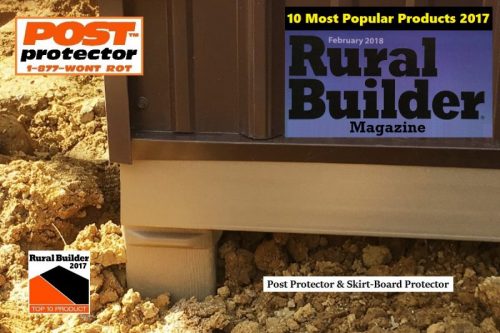Introduction
Post Protector is a “barrier system” used to extend the service life of the in-ground sections of pressure-treated posts/poles used to support structures such as pole barns or other “post-in-ground” projects such as decks, fences, pergolas, or retaining walls. It serves as an additional layer of protection by seperating the wood from moisture and decay fungi in the soil and/or manure or wet hay in barn stalls. We refer to it as being part of a “system” as a pressure treated post in conjunction with a Post Protector is clearly a superior “post-in-ground” method. This two-pronged approach exemplifies our “belt and suspenders” mentality, which drives our goal to achieve maximum performance.
Top #1 – How does decay occur?
For post-in-ground decay to occur, three conditions must first be in place.
- Oxygen
- Temperature between 40-100 degrees Fahrenheit
- Moisture (Generally, minimum 28% moisture content)
When these conditions exist, the soil-dwelling fungi, bacteria, and insects are able to colonize the post and use the wood fiber as their food source. A common misconception is that moisture is the “cause” of decay when it is actually one of the “conditions” that needs to be present to enable the micro-organisms to grow.
Topic #2 – How does a “barrier system” work?
Post Protector slides over the post prior to setting the post in the ground. The top edge of the Post Protector will be approximately 4”-6” above grade or finished floor grade on a post-frame building application.
To prevent decay, you need to eliminate one or more of its “ingredients”. Those “ingredients” again are Oxygen, Temperature between 40-100 degrees F, and Moisture.
So, job #1 for the Post Protector is to eliminate “soil-to-post” contact to attack two vital “ingredients” needed for decay to occur.
- Micro-organisms – Soil-dwelling micro-organisms have limited access to the post to start their destructive feeding on the wood fiber.
- Moisture – Moist soil and surface water cannot influence moisture content and drive wood fiber to its saturation point.
Another benefit of the Post Protector is that it eliminates any preservative chemical leaching that may occur over time, keeping the chemical treatment in the wood.
Topic #3 – Chemical Treatments/Environmental/Leaching
The chemical treatments used to protect wood from decay are pesticides. They are used to “poison” the wood fiber so that micro-organisms, or any other subterranean insects, will not feed on it. Chemical treatments are effective but there are many variables that can affect performance such as, lumber quality, treatment absorption quality, soil conditions, etc. Posts set directly in soil are certainly not the optimum condition for it to minimize its service life. Many of the new treatments have “yet to be determined” long term performance and suffer from “leaching” or “migration” issues. In addition, the Post Protector barrier system will prevent leaching of any supplemental preservative treatments that may be applied to the below-ground sections of posts/poles. “Leaching” is when the chemical treatment leaves the post over time resulting in longevity and environmental issues. With this said, it’s obvious why we believe combining a treated post with a Post Protector eliminates many issues that can result in post decay.
Topic #4 – How does Post Protector work on “outdoor” application like a fence, deck, or pavilion?
On “outdoor” post application (deck, fence, pavilion, etc.) the top edge of the Post Protector is subjected to rain and snow. By simply utilizing the optional drainage hole located on the base uplift protection rib, rainwater can run through the Protector and exit. Drainage is maximized when the recommended 6” of washed gravel is used as initial back-fill material. The balance of the back-fill material can be soil, concrete, stone, etc. The Post Protector also has vertical venting channels designed to assist in the draining and drying the post. All the while the Post Protector is in place to deny access of soil-dwelling micro-organisms.
Click on the images below to view examples of post decay:
[Not a valid template]









